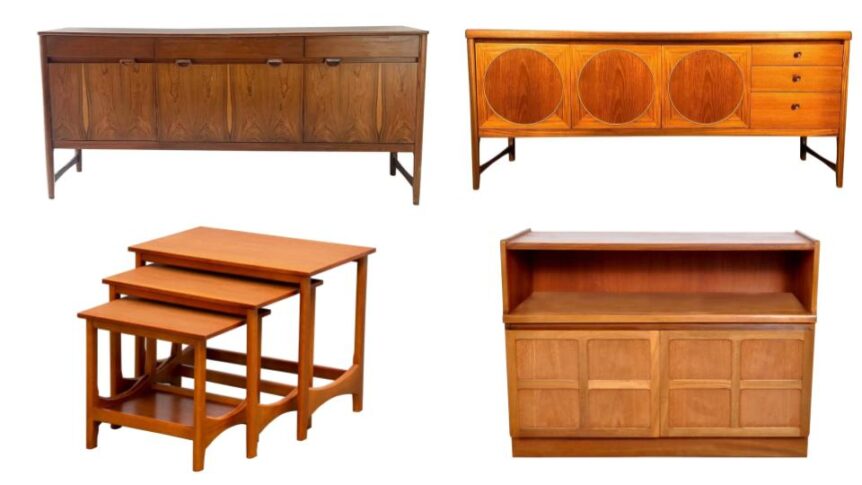Learn the hallmarks of authentic vintage Nathan furniture including branding stamps, mid-century design traits, material choices, and more.
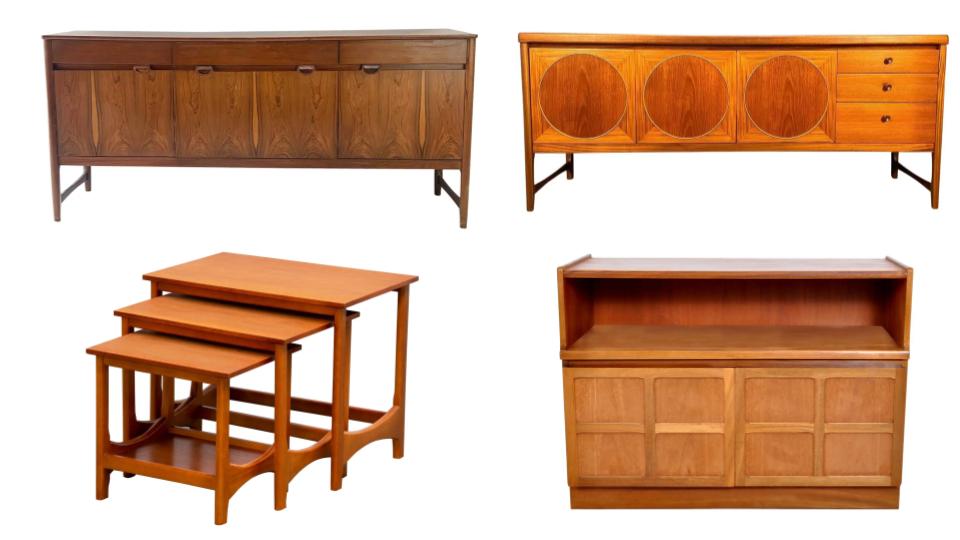
Mid-century modern furniture has been slowly growing in popularity over the last decade and is now one of the most sought-after vintage styles for adding a touch of class to contemporary homes.
And you can see why – it was built to last by manufacturers like Nathan who placed an emphasis on quality craftsmanship and designed pieces with both aesthetics and functionality in mind.
However, because of the popularity of mid-century modern furniture, contemporary manufacturers are creating new items in this style, making it harder to identify authentic mid-century pieces.
So how can you tell if a piece of furniture is a true vintage Nathan original?
There are a few techniques you can use to identify Nathan mid-century modern furniture including looking for the manufacturer’s stamps, considering the functionality, examining the design features like minimalist shapes and clean lines, noting the colors and materials used, and inspecting the construction methods.
I’ll go into more detail on how to examine these elements to determine if a piece is an authentic mid-century modern Nathan original or just a modern replica.
A Brief History of Nathan Furniture
To start, it helps to understand a bit about Nathan as a company. Nathan Furniture was founded in London in 1916 by Arthur Nathan. It began as part of the prominent Harris Lebus furniture group, with Nathan operating as its own distinct brand focused on high-quality cabinetry and case goods even in these early years.
By the 1930s, Nathan was gaining renown for its bedroom and dining room collections. Post-World War II, the company really came into its own as a leader in mid-century modern furniture design. Nathan embraced the stripped-down Scandanavian-inspired aesthetic that was fashionable in the 1950s and early 1960s.
The company’s designers created iconic sideboards, dressers, desks, and upholstered chairs that embodied mid-century ideals of minimal ornamentation, simple tapered legs, and clean lines. Nathan stood out for its meticulous craftsmanship and use of rich woods like teak and rosewood. Many of Nathan’s creations from this era are now collector’s items for vintage decor lovers and enthusiasts.
How To Identify Nathan Furniture
Below are a few ways you can identify authentic 1960s and 1970s mid-century Nathan Furniture.
1. Look for Nathan’s Branding Marks
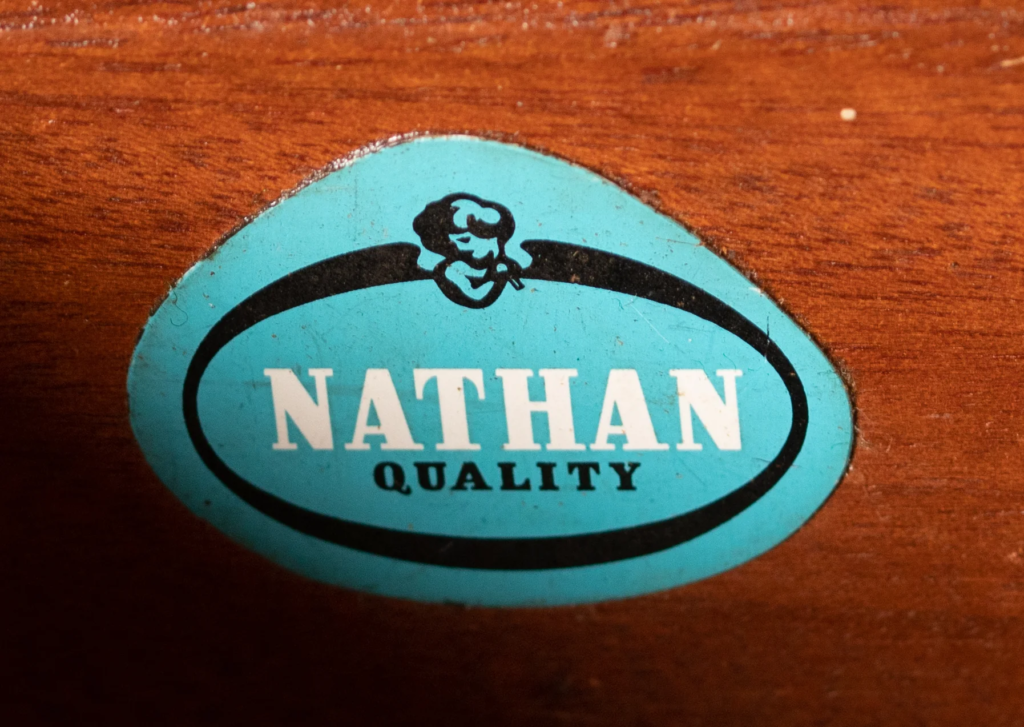
An easy starting point in identifying authentic Nathan furniture is to check for the original branding marks. Nathan typically stamped or labeled its pieces discreetly on the back panels, inside drawers, or on interior side sections.
Look for the full “Nathan” name, the stylized “N” logo, or the abbreviated “NATH” stamp. You may also find model names or numbers like “Stripe” or “Circula” that can help positively ID a Nathan product.
For seating like sofas and chairs, examine underneath the frames as Nathan sometimes branded these in inconspicuous spots. The label or stamp designs evolved through the decades but always included the Nathan name in some form.
If you locate an original manufacturing stamp or plate, you can be confident that piece is a bonafide Nathan vintage article.
2. Functionality and Daily Use in Mind
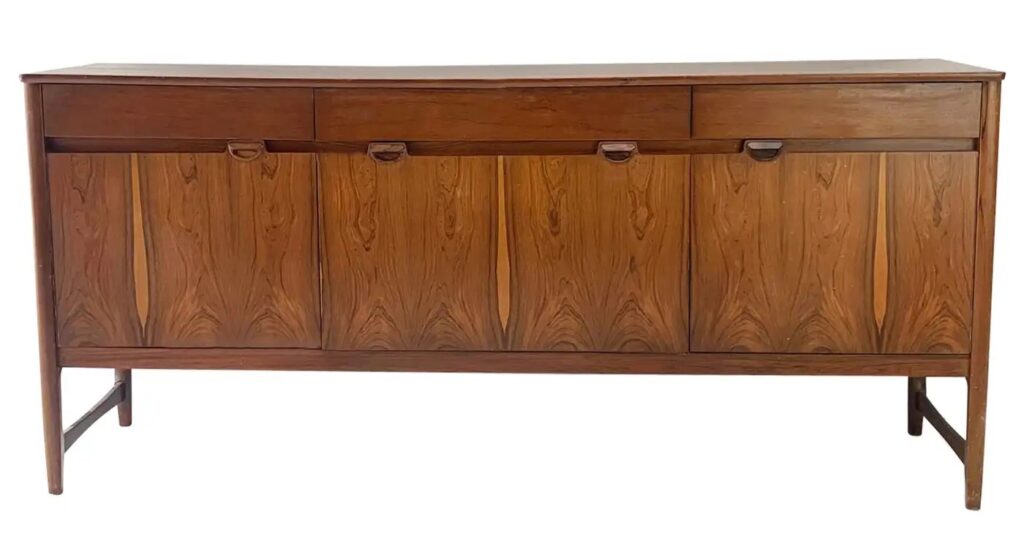
In addition to branding, you can identify Nathan furniture by considering its functionality and intended use in the mid-20th century home. Nathan designed its pieces around the lifestyles and spatial needs of the day.
For example, some quintessential Nathan items included:
- Streamlined sideboards to store and display dinnerware in dining rooms
- Slim dressers and wardrobes for modestly-sized bedrooms
- Writing bureaus as desk spaces before the advent of home computing
- Breakfront cabinets for storage along with a display of collectibles
- Entryway credenzas with racks to organize keys and mail
While these functions may seem slightly outdated today, the intended versatility and practicality point to Nathan’s mid-century modern approach. The furniture worked seamlessly into both cozy British homes as well as the sleek minimalist interiors of the era.
Related articles:
- How To Identify Mcintosh Of Kirkcaldy Furniture
- 10 Best Vintage Danish Furniture Brands of the 1960s and 1970s
- How to Identify G-Plan Furniture
- How to Identify Ercol Furniture
3. Examining the Stylistic Design Elements
Nathan’s furniture is also distinguishable by its adherence to mid-century modern design tenets. The company wholeheartedly embraced the philosophy of simple, uncluttered forms and clean lines.
Some specific design elements to look for include:
- Simple geometric shapes like rectangles, circles and boxy forms
- Visible, natural-finished quality wood grains
- Slim tapered legs, sometimes splayed or set at angles
- Limited ornamentation without intricate carvings
- Smooth lacquered finishes in neutral tones
- Integrated handles rather than pronounced pulls
- Subtle patterns vs. bold prints in fabrics
- Sculptural frames on lounge chairs
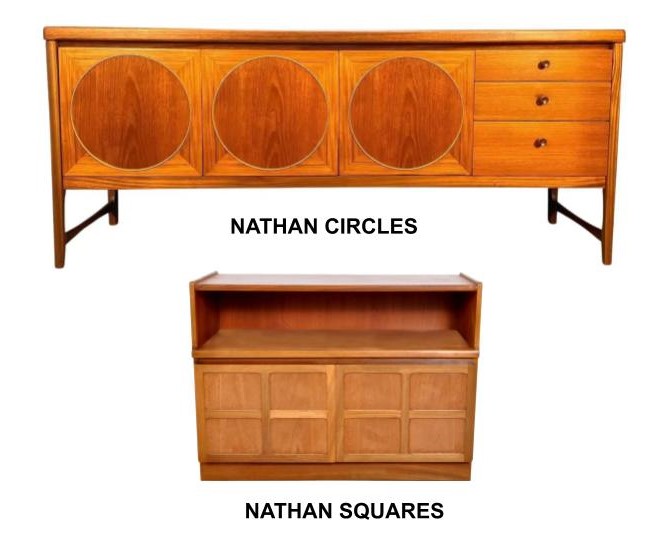
These details reflect both Scandinavian influences and the British interpretation of mid-century modernism. Nathan designers fused continental concepts with British sensibilities to create this distinctive look.
Related articles:
- 15 Best Mid-Century Sideboards (1960s-1970s)
- 15 Best Vintage American Furniture Brands
- How to Identify Stag Furniture: A Comprehensive Guide
4. Materials and Construction Techniques
The materials and methods Nathan used in crafting its furniture also provide clues toward properly attributing pieces to the brand.
Nathan relied on high-quality solid woods like teak, walnut, acacia and rosewood, rather than cheaper composite boards, setting it apart from lower-end manufacturers.
The company was also an innovative early adopter of new synthetics like molded plastic and acrylic glass in the 1950s. Pairing these materials with fine woods was common, like lacquered surfaces over wood veneer.
For construction, Nathan was renowned for its expert joinery. Dovetail joints fastened drawers, while dowel pins and tongue-in-groove connected other components. Multi-step finishing produced glassy lacquers. These meticulous techniques required great skill and defined Nathan’s exacting standards.
Related Questions
Is Nathan Furniture collectible?
Yes, vintage Nathan furniture is considered very collectible and desirable on the current market. As a well-known mid-century brand, Nathan pieces in good intact condition command high prices among both vintage furniture collectors and interior design enthusiasts.
Iconic items like rosewood credenzas, lounge chairs with original upholstery, and teak dining sets tend to be most valuable and sought-after at auction. Even more common Nathan furniture can sell for hundreds to thousands based on condition and rarity.
What wood is Nathan furniture made from?
Nathan primarily used high-quality solid hardwoods like teak, oak, walnut and rosewood in constructing much of its mid-century furniture. The company was known for its meticulous joinery and finishing of these fine woods.
Nathan also incorporated wood veneers over manufactured boards in some pieces. Innovative for the time, the brand integrated new synthetic materials like plastic laminates and acrylic glass into designs alongside real wood. These material choices were ahead of the curve in the 1950s and 1960s and remain hallmarks of authentic Nathan furniture today.
Key Identification Tips for Nathan Furniture
When trying to verify if a furniture find is actually a Nathan original, keep these tips in mind:
- Search for Nathan branding marks, logos, or paper labels
- Analyze if the form and function suit a mid-century lifestyle
- Check that the aesthetic aligns with mid-century modern tenets
- Evaluate construction including joinery, hardware, and finishing
- Note material choices like teak or walnut wood
- Assess quality and weight – does it feel substantial?
With keen observation skills and knowledge of Nathan’s trademarks, you can confidently identify authentic mid-century creations from this iconic British furniture company.

